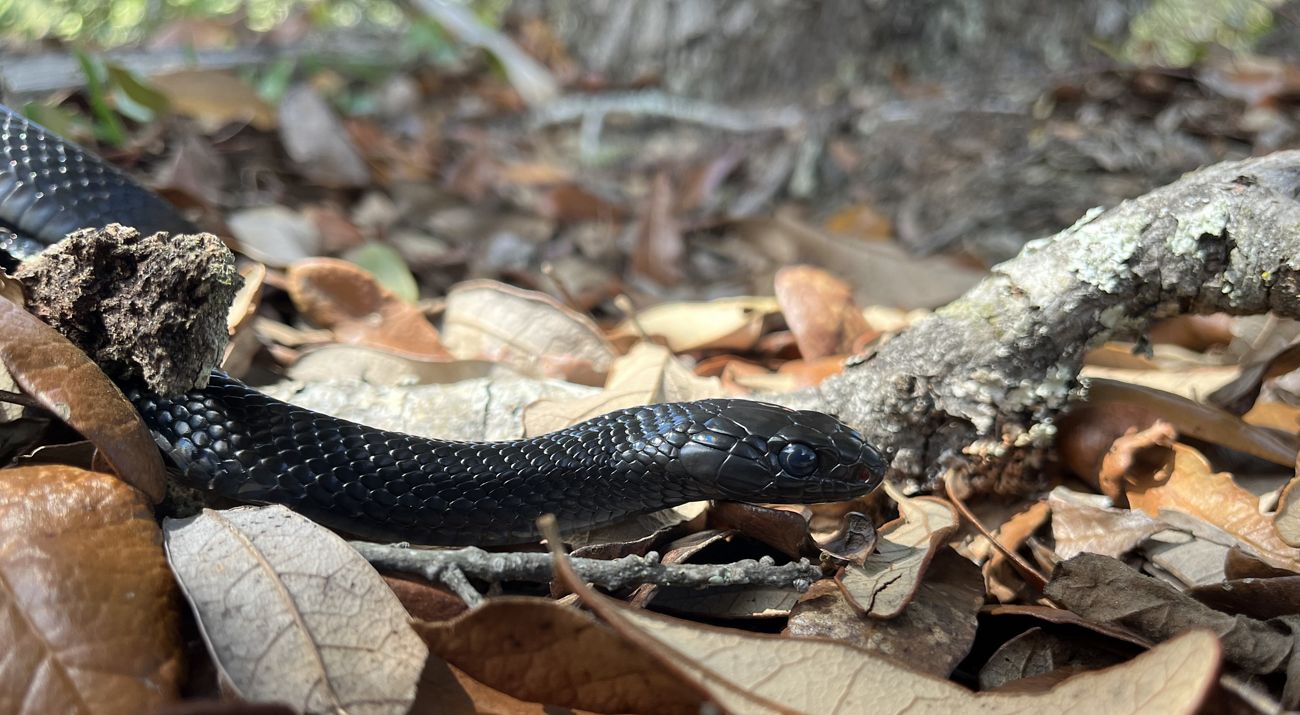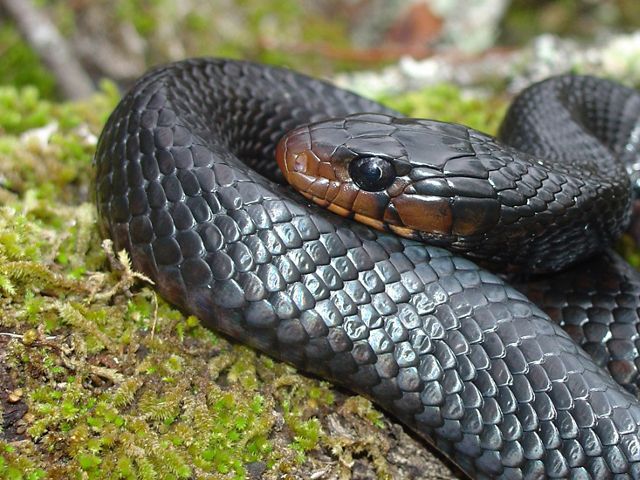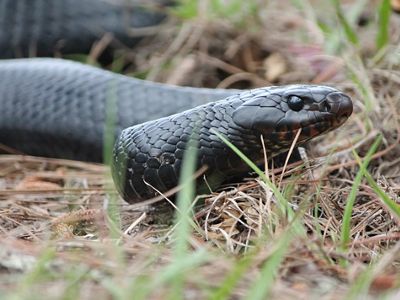Conservation Victory: Two Federally Threatened Eastern Indigo Snake Hatchlings Discovered at TNC’s Apalachicola Bluffs and Ravines Preserve
Hatchlings mark a significant milestone in decades-long habitat restoration and multi-partner recovery effort to save the threatened species.

Media Contacts
-
Fran Perchick
The Nature Conservancy
Phone: 561-328-9221 x205
Email: fran.perchick@tnc.org -
Carson Pena
The Nature Conservancy
Phone: 352-218-2945
Marking a milestone of conservation success, two wild-born Eastern indigo snake hatchlings have been observed at The Nature Conservancy’s (TNC’s) Apalachicola Bluffs and Ravines Preserve (ABRP) in Bristol, Florida. Over the past seven years, TNC and partners have released Eastern indigo snakes to the preserve, the only reintroduction site in Florida currently selected to support recovery of the species, federally listed as threatened under the Endangered Species Act. The wild-born hatchlings are further confirmation that the previously released snakes are flourishing among the restored longleaf pine landscape, and conservation efforts in preserving ecosystems and creating healthy habitats play a vital role in benefitting the interconnected species within them.
“Bringing a species back from the brink is reliant on functional ecosystems, like the longleaf pine and wiregrass habitat at The Nature Conservancy’s Apalachicola Bluffs and Ravines Preserve,” said Preserve Manager Catherine Ricketts, The Nature Conservancy in Florida. “The discovery of two Eastern indigo hatchlings demonstrates that 40-plus years of restoration and management work by TNC and partners has created a place where Eastern indigo snakes are now beginning to build self-sustaining populations.”

Rare longleaf pine habitat and vast wildlife corridors are essential for diverse wildlife and for the Eastern indigo snake, which requires large, connected tracts of land and may travel three miles or more in search of mates, new habitat and prey. An apex predator, the snakes serve a critical function in the wildlife community by consuming a variety of small animals including both venomous and non-venomous snakes, enabling balance for species such as songbirds.
"Since Eastern indigo snakes have not been seen in this region since the early 1980s, the news of discovering two hatchlings suggests that our reintroduction efforts are working. Not only are the reintroduced snakes surviving, but they are also reproducing! After all the effort and care for these animals by the entire OCIC Team, it warms the spirit to see signs of success," said Dr. James Bogan, director, Central Florida Zoo's Orianne Center for Indigo Conservation (OCIC).
Quote: Catherine Ricketts
The discovery of two Eastern indigo hatchlings demonstrates that 40-plus years of restoration and management work by TNC and partners has created a place where Eastern indigo snakes are now beginning to build self-sustaining populations.
“Decades of innovative ecological restoration work at TNC's Center for Conservation Initiatives' Apalachicola Bluffs and Ravines Preserve have led to this point, welcoming this keystone species back home to its native sandhill habitat,” said Andrew Rappe, preserve management director, The Nature Conservancy in Florida.
Healthy longleaf pine forests, like those restored at ABRP, are home to hundreds of types of plants and animals, including many species that are threatened or endangered such as the gopher tortoise, whose burrows provide shelter for the Eastern indigo snake and other animals. ABRP is forested with pines and intersected with resource-rich ravines and streams and is one of the most unique and biodiverse areas in the U.S.
“The discovery of two wild-born Eastern indigo snake hatchlings is very encouraging. It indicates we are successfully reestablishing the species where it once occurred. It’s exciting too, as we are celebrating the 50th anniversary of the Endangered Species Act, enacted in 1973 to prevent the loss of endangered and threatened species and to preserve the places they live. This Eastern indigo snake recovery program is an excellent example of the power of partnerships to recover species,” said Michele Elmore, Fish and Wildlife biologist, U.S. Fish and Wildlife Service.


The species was largely eliminated from the region due to habitat loss and fragmentation. The efforts to reintroduce Eastern indigo snakes at the preserve is the long-term joint commitment of multiple nonprofit, agency and academic partners including The Nature Conservancy (TNC), the Central Florida Zoo & Botanical Gardens’ Orianne Center for Indigo Conservation (OCIC), the Florida Fish and Wildlife Conservation Commission (FWC), U.S. Fish and Wildlife Service (USFWS), USFWS Welaka National Fish Hatchery, The Orianne Society, Joseph W. Jones Ecological Research Center, Southern Company through the National Fish and Wildlife Foundation (NFWF) and the Fish & Wildlife Foundation of Florida. These partners have collaborated for decades to restore and manage the longleaf pine habitats required by the snake, and many other species, to make the population reintroductions possible.
Over the past seven years, TNC and partners have released 126 Eastern indigo snakes at ABRP, each with a PIT (passive integrated transponder) tag for individual identification. The two hatchlings that were discovered do not have tags—additional confirmation that these hatchlings are wild-born offspring of previously released snakes reintroduced beginning in 2017. The two hatchlings have now been tagged, to facilitate monitoring of the activity and health of the introduced population and their wild-born offspring.
"Finding not only one but two hatchling Eastern indigo snakes at our Florida reintroduction site is a significant milestone and is evidence that the snakes are thriving post-release. Our monitoring efforts will continue to help us better understand how the snakes are navigating the landscape and interacting with one another throughout multiple generations," said Michelle Hoffman, field biologist, Central Florida Zoo's Orianne Center for Indigo Conservation.

The collaborative monitoring, research and release efforts have been instrumental in the success of the reintroduction program. This coordinated approach has ensured the survival and recovery of the Eastern indigo snake at the preserve as well as an additional Eastern indigo snake reintroduction site at Conecuh National Forest in southern Alabama.
“We are thrilled to learn about the observations of hatchling indigo snakes at Apalachicola Bluffs and Ravines Preserve,” said Bradley O’Hanlon, reptile and amphibian conservation coordinator for the Florida Fish and Wildlife Conservation Commission. “Our staff and project partners have put in significant effort to set this project up for success over the last seven years, and this is an encouraging sign that the effort is worthwhile. Attempting to recover a species, especially through reintroductions, is a massive undertaking and has only been made possible through the Eastern indigo snake recovery program. We are grateful for the collaboration between partners and are looking forward to continued project success.”
Across nine states in the U.S. southeast, TNC and partners are working together to restore and manage longleaf pine forest from Texas to Virginia, across its historical range. Longleaf pine once dominated the coastal plain blanketing more than 90 million acres. Today there are just 5.2 million acres, up from a low of 3.2 million acres two decades ago. TNC and partners continue conservation efforts across Florida, the U.S. and around the world to support healthy corridors of land and the ecosystem services, plants and animals they support.
The next release of Eastern indigo snakes to support the recovery of the species in north Florida is planned for spring 2024 at TNC’s Apalachicola Bluffs and Ravines Preserve.
Note: The Eastern indigo snake is legally protected by the Endangered Species Act and handled by TNC under USFWS permit ES26554C. As efforts to protect Eastern indigo snakes continue, we remind the public that pursuing, chasing, handling, capturing, harming or any attempt to physically engage with live or dead snakes is federally prohibited without a permit.
The Nature Conservancy is a global conservation organization dedicated to conserving the lands and waters on which all life depends. Guided by science, we create innovative, on-the-ground solutions to our world’s toughest challenges so that nature and people can thrive together. We are tackling climate change, conserving lands, waters and oceans at an unprecedented scale, providing food and water sustainably and helping make cities more resilient. The Nature Conservancy is working to make a lasting difference around the world in 83 countries and territories (39 by direct conservation impact and 44 through partners) through a collaborative approach that engages local communities, governments, the private sector, and other partners. To learn more, visit nature.org or follow @nature_press on X.